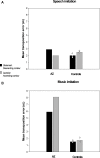Disorders of pitch production in tone deafness
- PMID: 21811479
- PMCID: PMC3140645
- DOI: 10.3389/fpsyg.2011.00164
Disorders of pitch production in tone deafness
Abstract
Singing is as natural as speaking for the majority of people. Yet some individuals (i.e., 10-15%) are poor singers, typically performing or imitating pitches and melodies inaccurately. This condition, commonly referred to as "tone deafness," has been observed both in the presence and absence of deficient pitch perception. In this article we review the existing literature concerning normal singing, poor-pitch singing, and, briefly, the sources of this condition. Considering that pitch plays a prominent role in the structure of both music and speech we also focus on the possibility that speech production (or imitation) is similarly impaired in poor-pitch singers. Preliminary evidence from our laboratory suggests that pitch imitation may be selectively inaccurate in the music domain without being affected in speech. This finding points to separability of mechanisms subserving pitch production in music and language.
Keywords: cognitive neuroscience; congenital amusia; music cognition; pitch production; poor-pitch singing; speech production; tone deafness; vocal performance.
Figures



References
-
- Ackermann H., Wildgruber D., Riecker A. (2006). “Singing in the (b)rain: cerebral correlates,” in Music, Motor Control and the Brain, eds Altenmüller E., Wiesendanger M., Kesselring J. (Oxford: Oxford University Press; ), 205–222
-
- Apfelstadt H. (1984). Effects of melodic perception instruction on pitch discrimination and vocal accuracy of kindergarten children. J. Res. Music Educ. 32, 15–2410.2307/3345277 - DOI
-
- Assal G., Buttet J., Javet R. C. (1977). Musical aptitude in aphasics. Rev. Med. Suisse Romande 97, 5–12 - PubMed
LinkOut - more resources
Full Text Sources

